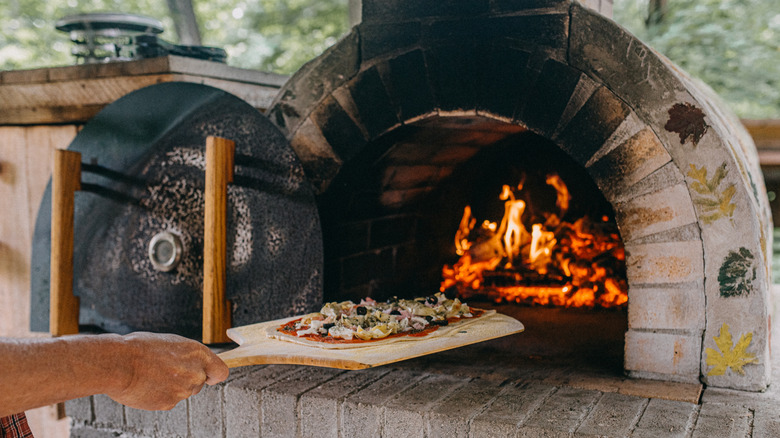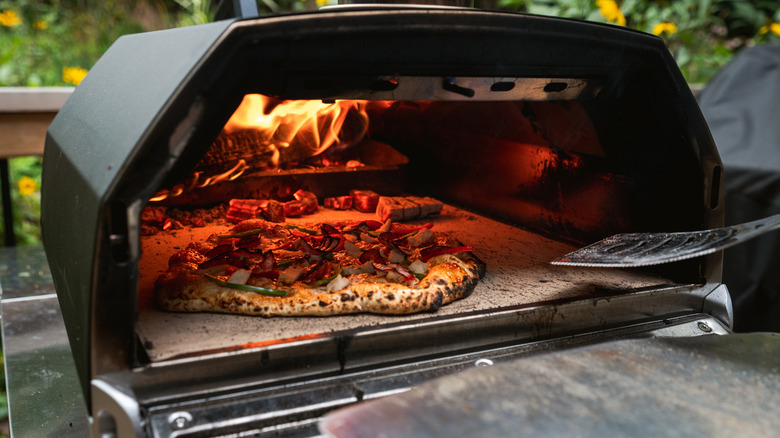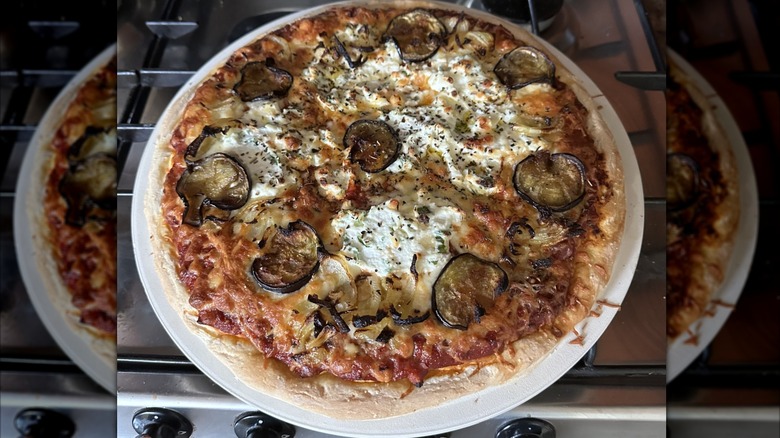Worth The Hype Or Overpriced: Are Pizza Ovens Worth It?
If you're at home and craving pizzeria-style pizza, there are several options for replicating the experience, even if you don't step foot out of your house. If you order in, there are lots of ways to perk up limp delivery pizza. Or you can give frozen pizza a glow-up by adding seasoning to the dough, or a few special toppings. You can also make your own dough from scratch and use a pizza stone or pizza steel in a conventional oven. Sadly, whatever you choose, you just won't get the bubbly toppings, crispy crust, or smoky flavor of a wood-fired Neapolitan pie. An outdoor, portable pizza oven may be as close as you can get to authentic Neapolitan pies without building a permanent structure, but it'll cost you a little extra dough. Whether or not it's worth it, depends on how you slice it.
Traditional pizza ovens, like the type you'd find in a pizza shop or restaurant, work their magic because they use gas, wood, or electricity, to generate enough heat to reach temperatures as high as 900 degrees Fahrenheit. They also radiate that heat evenly around the pizza, perfectly cooking the crust, the sauce, the cheese, and any toppings. Home ovens cannot reach that same level of high heat (The maximum temperature is usually 500 degrees Fahrenheit) and, unless you have a convection oven that circulates heat, they cook from the bottom up.
How backyard ovens work
Backyard pizza ovens, designed to be small, portable, and for outdoor use, replicate the heating system of commercial ovens. Gas and propane models, like the Ooni Koda 16 pizza oven and Solo Stove Pi Prime propane pizza oven, heat up quickly and consistently, clean up easily, and cool down faster than models using wood and charcoal. The trade-off is in less-authentic flavor. There are ovens that use all three heat sources, but fewer models are available. All can cook 12- to 16-inch pizzas in as little as 60 seconds. The ovens are intended to be portable. But gas and propane versions require you to carry a tank, while wood and charcoal versions have a chimney for the flames that can make them awkward to move around.
Outdoor ovens are often pricier primarily because of their design. The materials need to be able to withstand the heat and cook the pizzas evenly. But, should you be wary of spending as much as $2000 for a setup that's only useful for making pizza, you'll be relieved to know most can cook other dishes such as bread, roasted vegetables, and steaks.
But users are split on the value of having a backyard oven. One Reddit poster waxed poetic when describing their experience, "What I didn't appreciate/expect before getting the pizza oven was the visceral experience of staring into the 1000-degree furnace and watching the dough and toppings transform, literally second by second. It's kind of thrilling, honestly." Others were more pragmatic, with one simply saying, "I'd rather spend my time and money elsewhere."
Using your grill or home oven to make pizza
One alternative to purchasing a backyard oven is to use a kit like the Kettle Pizza grill top pizza oven kit, which uses a metal box and a pizza stone insert to circulate heat — which can be nearly a third of the price of the least-costly pizza ovens. Although it takes longer for the grill to reach the same level of heat, the cooking time is still just six to seven minutes.
You can also use a pizza stone or pizza steel in your home oven. A pizza steel is a thin steel plate that quickly absorbs high heat. Options like the Pizza Steel Pro by Hans Grill can be preheated in the oven to cook pizza quickly and give it a nice crispiness. Alternatively, the Hans Grill Pizza Stone is made of a porous material that can aerate the dough as it cooks. It can cook the pizza more evenly than a steel, but not as quickly. Stones and steels generally range in price from $50 to $100.
Whether you're planning to invest in an outdoor oven, outfit your grill, or turn up the heat in your home oven with a new surface, avoid the common mistakes people make with pizza. Simple things like giving the pizza enough time to cook — or using enough water in the dough — can allow a $50 tool to make you feel like a pro.


